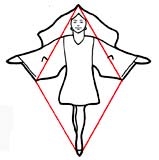Introduction
In the context of designing tessellations, an important aspect, indeed of fundamental importance, is that of what I term as duality of line, defined as a single line that serves two purposes in a tessellating motif. Escher refers to this as a ‘double contour', and briefly wrote about its function on two distinct occasions, firstly in 1947 in the magazine Phoenix (referring to the horseman tessellation, drawing 67):
… Note how each contour has a double function: a single line borders the mane as well as the belly of the horse; also the face of the rider as well as the neck of the animal are defined by one and the same line. A second occasion, of 1965, in the Preface of Symmetry Aspects of M.C. Escher's Periodic Drawings refers to essentially the same, although here Escher is referring to adjacent motifs:
… The border line between two adjacent shapes having a double function, the act of tracing such a line is a complicated business. On either side of it, simultaneously, a recognizability takes shape. But the human eye and mind cannot be busy with two things at the same moment and so there must be a quick and continuous jumping from side to the other… 1. Illustrating Duality of Line
An actual example of such duality is illustrated left and below, using my favourite tessellation, of Human Figures, No.1. The figure on the left shows the girl motif tessellating tile in isolation, thereby aiding the discussion without 'distractions' of contiguous figures of the plane tessellation.  . The two figures here show the construction and duality of the outline. Essentially, this drawing, i.e. the outline (the interior design being in the strictest sense 'decoration') consists of a single line, rotated 60° at the vertex of a rhombus, and then as a unit reflected over the long axis of the rhombus. Duality is shown by the emphasised line diagrams of this figure, with the emphasised line of the left figure represent the girls' hair, arm and hand, whilst the emphasised line of the right figure represents the dress, waist and leg.Now, from this, it can be seen that aspects of this are of more fundamental importance than others. For example, the line representing the waves of the hair is not vital as regards its veracity – the undulations do not need to be of specific nature. However, when the line is rotated, this now represents the contours of the entire length of the leg, of which such a shape is indeed of a more specific nature, of necessity an exact shape. Consequently, of these two aspects, by far the most important in terms of portraying the girl most realistically is that of the leg, and so more attention is thus paid to this in terms of anatomical accuracy for the sake of the inherent quality of the motif.
|